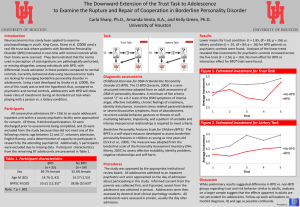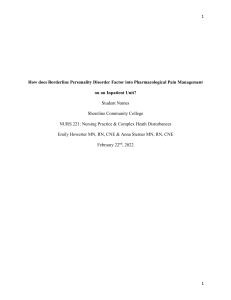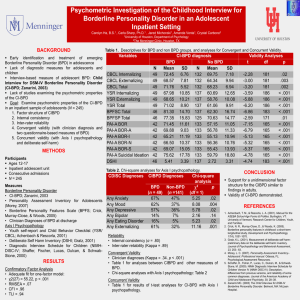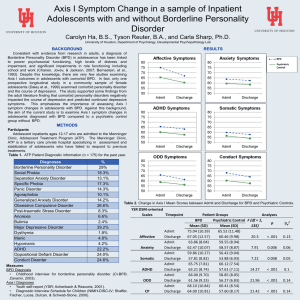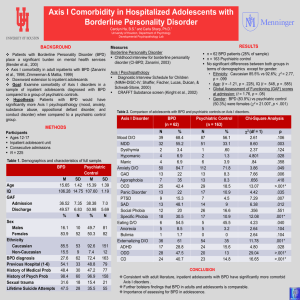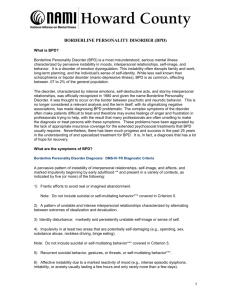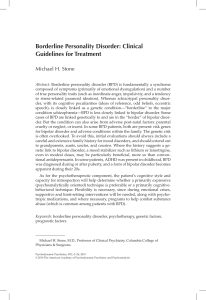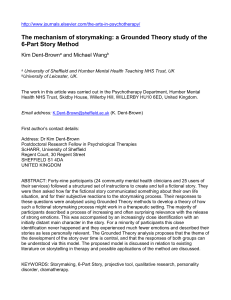Treating Borderline Personality Disorder in the Primary Care Setting Date: 11/20/2014
advertisement
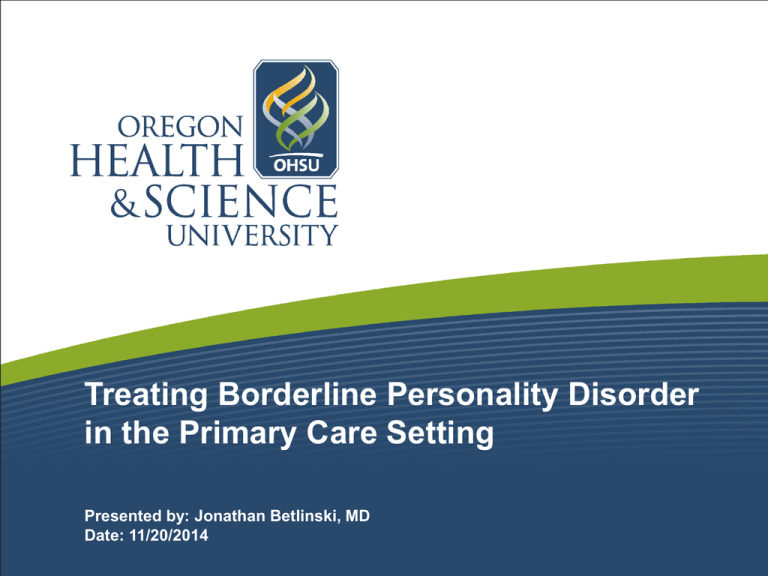
Treating Borderline Personality Disorder in the Primary Care Setting Presented by: Jonathan Betlinski, MD Date: 11/20/2014 Disclosures and Learning Objectives • Learning Objectives – – – – Be able to name three evidence-based therapies for BPD Be able to list the three basic tenets of Relationship Management Know 7 ways to improve outcomes in Borderline Personality Disorders Appreciate the role of hope in the treatment of BPD Disclosures: Dr. Jonathan Betlinski has nothing to disclose. Assessing Borderline Personality Disorder • • • • • • • Review BPD Review Pharmacotherapy Review Psychotherapy Review Relationship Management Review Office Management Review the UK approach Next Week Borderline Personality Disorder, DSM-IV TR A pervasive pattern of instability of interpersonal relationships, self image, and affects, and marked impulsivity beginning by early adulthood and present in a variety of contexts, as indicated by 5 (or more) of the following 9 criteria: • Frantic efforts to avoid abandonment, imagined or real • A pattern of unstable, intense relationships • Identity disturbance; unstable self-image or sense of self • Impulsivity in at least two potentially damaging areas • Recurrent suicidal behaviors, gestures, threats, self harm • Affective instability due to market reactivity of mood • Chronic feelings of emptiness • Inappropriate intense anger or difficulty controlling anger • Transient paranoia or severe dissociative symptoms http://www.psi.uba.ar/academica/carrerasdegrado/psicologia/sitios_catedras/practicas_profesionales/820_clinica_tr_per Borderline Personality Disorder • 1-4% of the general population • 6% of a primary care clinic population – 50% had no mental health treatment that year – 43% not recognized by PCP has having any emotional or mental health problems. http://archinte.jamanetwork.com/article.aspx?articleID=210746 • Higher rates of common health problems, perhaps due to medication-induced obesity – Diabetes, Hypertension – Chronic Back Pain – Arthritis, Fibromyalgia http://www.nimh.nih.gov/health/publications/borderline-personalitydisorder/Borderline_Personality_Disorder_508_141959.pdf Borderline Personality Disorder and Health • Medically self-sabotaging behavior • Increased perceptions of illness • Pain syndromes (BPD in 50% of chronic pain patients) • Prescription misuse and abuse • HIV • Skin picking or excoriation (1 in 4 have BPD) • Factitious illness • Plastic Surgery (more surgeries, less satisfaction) • Rheumatoid Arthritis (40% have BPD?) • Disability (3 times more likely) http://www.ncbi.nlm.nih.gov/pmc/articles/PMC3012616/pdf/PE_1_2_19.pdf Treating BPD - Pharmacology • SSRIs are recommended by the APA – • Mood stabilizers – – • Depakote may be helpful for rage Lamictal and Topomax may help Low-dose Antipsychotics – • Fluvoxamine, Sertraline, Fluoxetine Abilify, Olanzapine Avoid benzodiazepines http://psychiatryonline.org/pb/assets/raw/sitewide/practice_guidelines/guidelines/bpd-guide.pdf http://emedicine.medscape.com/article/913575-medication http://www.bpddemystified.com/treatments/medication/ Treating BPD - Psychotherapy • • • • • • Dialectic Behavioral Therapy Mentalization-Based Therapy Transference Focused Psychotherapy Schema-Focused Therapy General Psychiatric Management Systems Training for Emotional Predictability and Problem Solving http://www.bpddemystified.com/treatments/medication/ BPD – Relationship Management • Social Contract – – • Patient is intelligent, responsible and in control PCP does not make decisions or give advice Relationship Management – – – Do no harm Reduce chaos and curtail the distorted relationship between patient and health care Consider therapy http://www.ncbi.nlm.nih.gov/pmc/articles/PMC2379842/pdf/canfamphys00110-0101.pdf http://www.powells.com/biblio/62-9781138004993-1 Relationship Management, continued • Interview techniques – Slowing down the interview – Using fewer words – Increasing the use of silence – Responding with empathetic neutrality – Assuming a position contrary to assigned attributes http://www.ncbi.nlm.nih.gov/pmc/articles/PMC2379842/pdf/canfamphys00110-0101.pdf BPD – Office Management • Structure, Structure, Structure • Remain calm and go for the emotion • Watch for splitting • Notice your own feelings • Open, honest discussions about the role of emotions and life stressors in medical concerns • Partner up for physical exams • Educate about BPD • Know that Suicide and Self Harm will be issues http://www.ncbi.nlm.nih.gov/pubmed/17484331 http://www.learningace.com/doc/1139736/439fcb618548f7a4d233ad1696bca6de/borderline-presentation-4-16-09-print- BPD – The UK Approach • • • People with BPD should not be excluded from healthcare Work in partnership to develop autonomy and promote choice Develop an optimistic and trusting relationship – – – Many have experienced trauma Recovery is possible Be open, engaging, non-judgmental, reliable • Anticipate the end of relationships and support transitions • http://www.nice.org.uk/guidance/cg78/resources/guidance-borderline-personality-disorder-pdf Summary • • • Borderline Personality Disorder can disrupt healthcare BPD improves with time and hard work Treatment of BPD includes – – – – Avoiding harm Management of relationships Therapy Medications The End! Happy Thanksgiving! See you on December 4! http://www.allindiacelebration.com/wp-content/uploads/2014/11/Thanksgiving-Pictures-4.jpg
